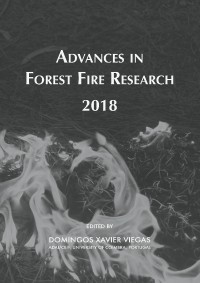Please use this identifier to cite or link to this item:
https://hdl.handle.net/10316.2/44594| Title: | Understanding unburned patches patterns in extreme wildfire events: a new approach | Authors: | Tedim, Fantina Royé, Dominic Bouillon, Christophe Correia, Fernando J.M. Leone, Vittorio |
Keywords: | Extreme wildfire events (EWE);fire intensity;Portugal;unburned patches (UPs);wildland-urban interface (WUI) | Issue Date: | 2018 | Publisher: | Imprensa da Universidade de Coimbra | Journal: | http://hdl.handle.net/10316.2/44517 | Abstract: | Burned area is a rather weak descriptor of wildfire activity, since it is not well correlated neither with fire severity and ecological effects, nor with socio-economic impacts. It ignores the heterogeneity in severity distribution within fire boundaries, and the existence of unburned patches (UPs). The purpose of this paper is to provide a first understanding of the trends and spatial patterns and characteristics of UPs within wildfires in Portugal as well as their explanatory variables. This research adopts a special focus on extreme wildfire events (EWEs), that represent a huge threat to society because of their high intensity, erratic behavior, and strong spot activity. Previous studies on UPs mainly followed an ecological approach, whereas our research is mainly focused on understanding how the area of wildland-urban interface (WUI) contributes to create UPs inside an EWE. This focus is of paramount importance to assist prevention and mitigation, in order to increase the safety of people and assets, in a context of more extreme fire environments. We selected as case study the Pedrógão Grande wildfire that occurred in 2017. This event is one of the most disastrous fires ever occurred worldwide, with the highest number of fatalities in a single event. We hypothesize that even in this category of fires it is possible to find UPs. Based on the wildfire perimeter dataset available, we estimated the UPs by the application of geometrical operations. The mapping of WUI was carried out by methods developed by IRSTEA and available in the Ruimap software. The WUI map was created by a combination of housing configuration and vegetation characterization or land use map. To relate the formation of UPs and the Pedrógão Grande fire intensity we used the shape file of the isochrons of fire spread provided by the Independent Technical Commission (CTI) created by the Portuguese Parliament to investigate 2017 wildfires. We created an UPs georeferenced database for Pedrógão Grande wildfire comprising several variables (e.g. size, land use characteristics, aspect, slope). Although the trend of UPs in Portugal from 1975 to 2017 is presented, the most innovative findings are related with the study case of Pedrógão Grande and the patterns and characteristics of UPs within this fire perimeter. This wildfire burned with different intensities and rate of spread but since the first thirty minutes after the ignition, fire burned above the extinction capacity (CTI 2017). In this EWE, unburned area within fire boundary were identified irrespective of fire intensity values, even in the most critical period when fire burned with intensity up to 60,000 kWm-1. Our findings corroborate the previous studies but others are in contrast with what has been published so far. One of the most interesting findings is that the largest UPs were formed in the interval of maximum intensity and are of the Mix UPs type. The implications of the findings of this research in land and wildfire management are exploited. | URI: | https://hdl.handle.net/10316.2/44594 | ISBN: | 978-989-26-16-506 (PDF) | DOI: | 10.14195/978-989-26-16-506_77 | Rights: | open access |
| Appears in Collections: | Advances in forest fire research 2018 |
Files in This Item:
| File | Description | Size | Format | |
|---|---|---|---|---|
| understanding_unburned_patches_patterns.pdf | 1.66 MB | Adobe PDF |  |
Items in DSpace are protected by copyright, with all rights reserved, unless otherwise indicated.
